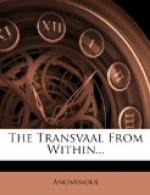A final effort was made by the people of Johannesburg to obtain the release on bail of the four prisoners. A petition bearing the signatures of 20,000 persons was presented; the gentlemen bearing the petition were informed that it could not be received; that they must call again. Having called again and again, the petition was at last accepted and placed before the Government; but no reply was ever vouchsafed. The treatment of this memorial is in sharp contrast with that accorded to the one presented by a score or so of the President’s relatives and supporters—objecting to the release.
From the time of the arrests until just before the trial speculation was rife as to which judge would preside. The Chief Justice and Judge Ameshof could hardly sit (even allowing for the precedents already established by them), since they had both acted on the Government Commission in negotiating with the prisoners, and one of them had already given evidence against the accused. There remained Justices Jorissen, De Korte and Morice. Mr. De Korte was then threatened with suspension owing to pecuniary embarrassments, and would evidently not be allowed to preside. The fifth judge, Mr. Jorissen, had expressed himself so violently against the Reformers that he had himself recognized the impossibility of attaining an impartial attitude, and had refused to sit. The only judge available was therefore Mr. Justice Morice, against whom there was no valid objection whatever. Moreover, in the ordinary routine it so happened that it was his turn to preside at the forthcoming trial; but he was known to hold Liberal views and to be strongly in sympathy with internal reform.
At this time Chief-Justice Kotze undertook several journeys to the Free State and Cape Colony, ostensibly to rid himself of insomnia, but in reality, as results proved, in order to employ a judge for this trial. His choice eventually fell upon Mr. Gregorowski, formerly a judge in the Free State, and at that time State-Attorney to that country.
Mr. Gregorowski was noted on the Bench for the peculiar severity of his sentences on all except Boers. He had moreover expressed openly in Bloemfontein his wish that he might have the trying of ’those Reformers; he would give them what for.’ These things were not known at the time of the trial; nor had the fact yet come out that before taking the oath of office he had endeavoured to borrow from at least one of his colleagues a black cap for the forthcoming




